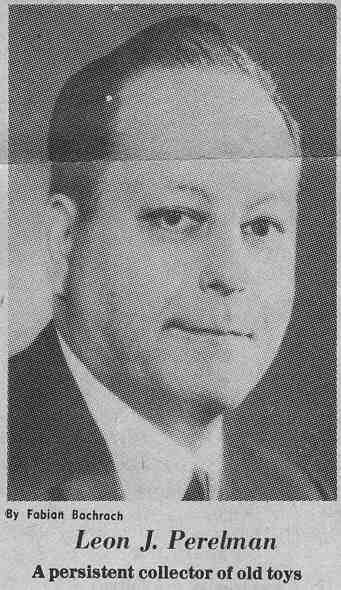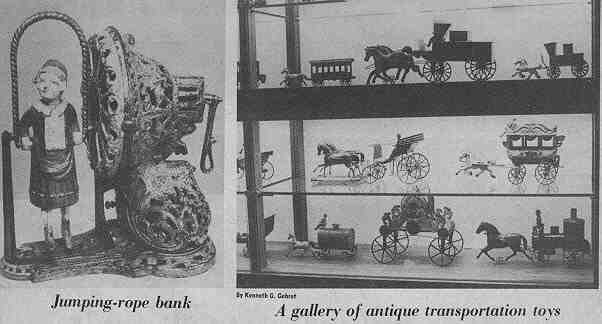‘frog in den,’ ‘jumbo’ elephant are part of
2,500-toy Philadelphia museum
By Kenneth G. Gerbert, Philadelphia
THE CHRISTIAN SCIENCE MONITOR, Thursday, March 16, 1972
 Leon J. Perelman is like
a child with a new toy. Except his delight is in playthings that are not new but old
— and he has lots of them. In fact, a whole museum full.
Leon J. Perelman is like
a child with a new toy. Except his delight is in playthings that are not new but old
— and he has lots of them. In fact, a whole museum full.
He shares his treasure trove of 2,500 toys and dolls with some 25,000 visitors who file by the glass-encased exhibits each year, many of whom seen as fascinated as Mr. Perelman himself by these reminders of an earlier period and life-style.
The collection is both extensive and varied. It is said to contain a cross section of every type of toy made in the United States from the post-Civil War era into the second decade of this century. It includes mechanical banks and other animated toys, toy vehicles from fire engines and stage coaches to hansom cabs and locomotives, beautiful marbles of glass and "carpet" bowls for indoor use, walking dolls, and even a French Music box with five musical figures that move. (The last is a rare exception to the Americana theme of the exhibit.)
Mr. Perelman is likely to take a personal guest first to the section that displays mechanical banks. This is the nucleus of the collection and the owner’s favorite. He claims it to be the largest assemblage of these thrift toys in the nation.
225 Mechanical banks
Mechanical banks were patented from 1865, and the first one was manufactured two
years later. Their popularity continued until 1902. Of 243 known types of such banks, the
Perelman museum holds 225. Most of them are made of cast iron, and each performs some
mechanical action or stunt.
For example, place a penny in the muzzle of a rifle and press a lever — bang! The penny shoots into a tree stump, and a bear pops out. Or put a penny in the slot in the harlequin bank and watch three figures turn on a rotating platform, while one of them also twirls about independently.
Most mechanical banks are not as complex as these two. More typical are the "frog in den" bank, with the frog reaching out his tongue to grasp the coin and deposit it inside his body; and the "jumbo" elephant bank in which the penny is propelled to a slot in the animal’s back by a jerk of his trunk when the tail is pulled.
The most valuable banks in the Perelman collection go through just such simple movements. One is the "Uncle Sam" bank. The figure nods a "thank you" gesture when a penny is placed in his outstretched hand; the hand drops and the coin slips into a carpetbag by Uncle Sam’s side.

Few specimens found
One of the rarest specimens in this group is the freedman bank. Only six are known
to exist. One reason few have been found, Mr. Perelman speculates, is that very likely
only small numbers were made or sold because of the high original price — $4. Most
banks of the period cost between 25 cents and $1.
While perhaps somewhat less valuable than the freedman bank, a turtle bank cost Mr. Perelman considerably more. He won’t estimate publicly the value of the total collection, but he admits having paid $12,000 last year for the turtle bank alone. Only two were known to exist until this one was found.
A partner in a paper company with 11 plants scattered about the country, Mr. Perelman has traveled widely and has pursued his hobby with unflagging zeal. In fact, it was on one such business trip that he first learned about mechanical banks — at a hobby show in Fort Madison, Iowa.
"I was fascinated," he says, "and would go to see dealers and attend antique shows as I traveled around. That was in 1958. Soon I added still banks in my search, then toys in general."
The determination that this collector can muster for the task is indicated in the story he tells about "the girl in the Victorian chair." He heard that a specimen of this mechanical bank was owned by a farmer some 40 miles from Philadelphia. The address was incomplete. So he set out about dinner hour one evening. Snow began falling. Asking directions at one stop after another, he made slow progress to his destination but finally reached the farmer’s house by 9 or 10 p.m.
Search conducted
The farmer acknowledged that he had the bank and was willing to part with it for
$100. But he didn’t know where it was; he would look for it later. Mr. Perelman was
determined not to go away empty-handed. He would help the man look and give him $125.
They went to the attic, without success. The farmer wanted to put the search off. The collector raised the price to $150. It kept going up until, finally, at midnight Mr. Perelman had his bank — and the farmer his $200.
Mechanical banks and other antique toys are now so rare that the museum owner no longer looks for them personally. "All topnotch dealers know me and get in touch when they find something of value," he declares.
To this dedicated hobbyist the toys are important since "they are part of the American heritage." And he opened the museum, at considerable personal expense, because "it was crazy to accumulate and not have other people see the collection."
Mr. Perelman’s Antique Toy Museum (270 South Second Street) is located in Philadelphia’s old city near the waterfront. Restoration and new residential construction have improved the entire area. The museum itself is a historically restored house dating from 1785. It is open daily except Christmas and New Years Day from 9:30 a.m. to 5 p.m. for a nominal admission charge.
